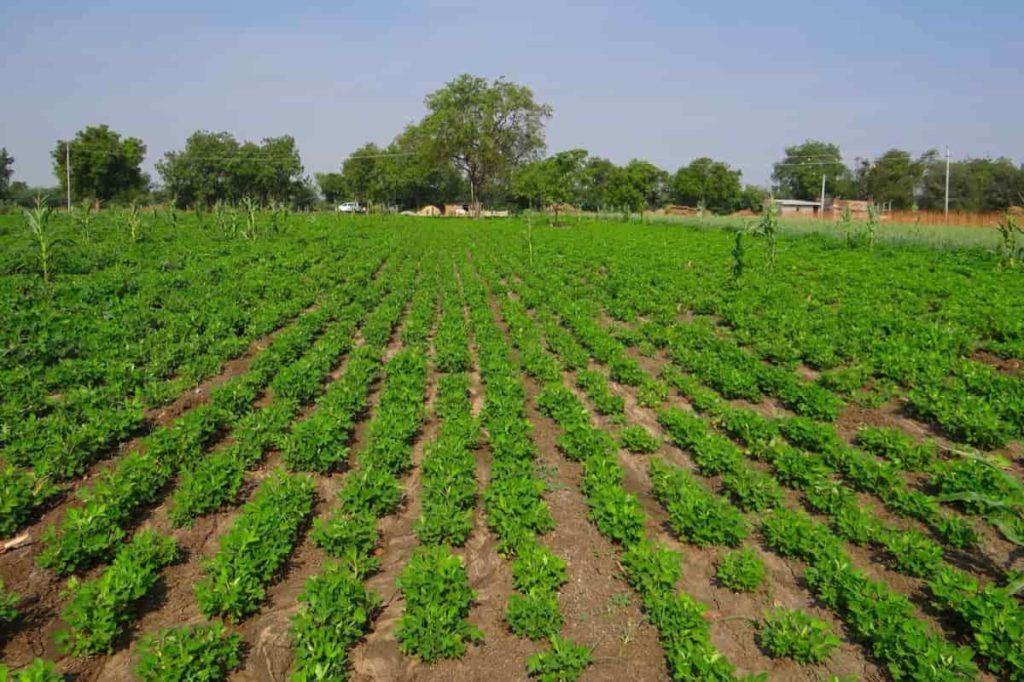autos-vehicles

May 06,2025 • 4 min read
Best Practices for Groundnut Farming: A Success Guide

In India, groundnut or peanut cultivation is a very common farm practice. They are grown for the edible seeds that are later used to make oil, snacks, and many other foods. India ranks among the top producers of this crop globally, with states like Gujarat, Andhra Pradesh, Tamil Nadu, and Rajasthan being the major producers. Its cultivation needs good land preparation, water supply, sowing of seeds, controlling pests, and harvesting in order to have a good crop.
This guide explains all the steps to grow groundnuts successfully.
7 Major Stages for Groundnut Cultivation
Groundnut farming is done in different stages. Each stage is important for the plant to grow well and give a good harvest. You can read about these stages below:
-
Land Preparation
The first step in the farming process is the preparation of the land. This includes clearing the field of any weeds or stones that could harm the plants. This crop grows best in well-drained, sandy loam or light clay soil, which gives enough space for the roots to grow. The ph has to be between 6.0 and 7.0, which is slightly acidic to neutral.
Tractors like the Farmtrac 45 are mostly preferred by farmers to plough and till the soil, making it soft and well-aerated. It has a powerful 45 HP engine with 38.3 PTO HP, capable of easily handling various farm work. Moreover, the Farmtrac 45 price starts at Rs 6.90 lakh and goes up to Rs 7.17 lakh.
-
Seed Selection and Planting
The correct choice of seed is crucial to ensuring a bountiful harvest. India has numerous varieties to offer, including Runner, Spanish, and Virginia. The selection must be made considering the location as well as the weather conditions. Proper seeds with resistance to disease and well-fitted to the soil conditions of that place must be selected.
Seeds are usually sown in rows, with about 15–20 cm spacing between seeds. The planting depth should be approximately 4–6 cm. Seeds can be planted using tractors equipped with seed drill attachments. Groundnuts are usually sown during the monsoon season in areas with normal rainfall.
-
Irrigation and Watering
Groundnuts require good watering for proper growth, but they do not grow in waterlogged soil. Overwatering may cause root rot; hence, effective irrigation management is important. In low-rainfall areas, irrigation schemes such as drip irrigation or sprinkler systems are used. These systems directly provide water to the roots and conserve water.
More water is required for the plant when flowering and while pods (nuts) are being formed. While in the early stage, plants require moderate watering. After plants start flowering, watering requirements become higher. One must prevent water stress at this point as it influences yield.
-
Pest and Disease Management
Like all crops, groundnuts are prone to pests and diseases that harm the crop and lower yield. Aphids, whiteflies, and caterpillars are some of the most common pests. Insecticides or natural predators such as ladybugs can be used to control them. Early detection and control of infestation are essential through regular monitoring of the crop.
In addition, leaf spot and rust diseases also attack the plants. Fungicides are used to prevent fungal infections. Rotating with other crops is also necessary to lower the concentration of pests and diseases in the soil.
-
Fertilization and Growth
Fertilization plays a significant role in the healthy growth of the crop. Initially, organic manure or compost is applied to the soil to provide essential nutrients. Later, a balanced fertilizer containing nitrogen, phosphorus, and potassium is applied to support plant growth and development. Phosphorus helps the roots grow well in the early stages.
-
Harvesting
Harvesting groundnuts is an important part of the farming process. This process is normally done when the plants start turning yellow, and the leaves begin to dry. The pods develop underground, and hence, farmers use a tractor or a plough to dig up the plants. The groundnuts are then carefully pulled out from the soil.
-
Post-Harvest Handling
Once harvested, the groundnuts are dried properly. They are laid out under the sun for several days to drain excess water. Afterwards, they are sorted into various grades depending on quality and size.
The Mahindra Arjun 605 tractor is best for post-harvest operations such as pulling and transporting the crop. With a 57 HP engine power and a lifting capacity of 2,000 kg, it can easily handle heavy loads. This makes the entire post-harvest operation smoother and easier for farmers. In addition, the Mahindra Arjun 605 Price also varies from Rs 9.36 lakh to Rs 9.57 lakh.
Conclusion
Overall, groundnut cultivation is a suitable means of earning income for Indian farmers. It does not need an extremely large amount of investment and can yield good returns if properly done. Farming equipment and tractors can ease and speed up the work, allowing farmers to earn a better income.
vishalsamadhiya Details
User Profile
- Full name
- vishalsamadhiya
- Email address
- vishalsamadhiya93@gmail.com
- Join Date
- 2025-05-06
- State
- City
- Pincode
- Address
- Follow us on Facebook
- Follow us on Twitter
- Website Name
- Bio